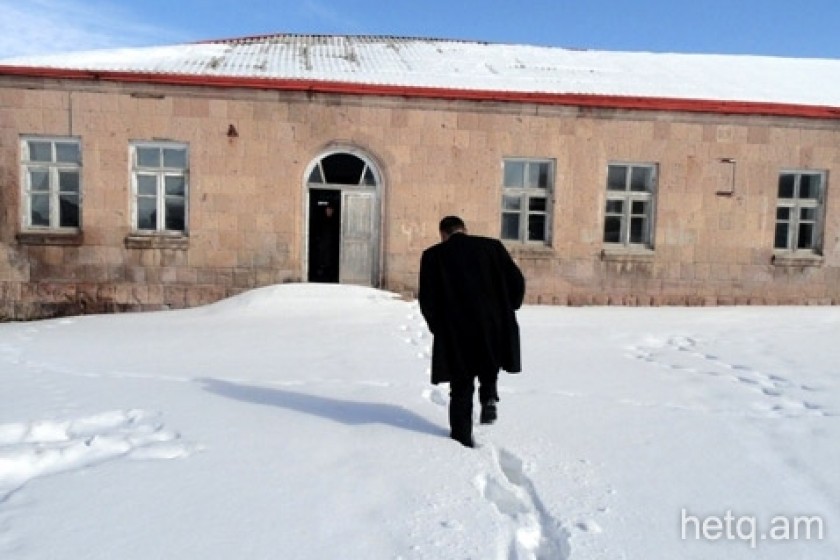
Lernakert’s Quandary: Many Projects but Little Money
The road to Lernakert’s dilapidated cultural center hasn’t been cleared of snow for the past two months.
The one story building was built in the 1960s and houses a portion of the village’s 4,000 books. Nazani Simonyan, the village’s dedicated and long-time librarian, says that the rest have been transferred to her house for safe keeping.
“I can’t complain,” says Simonyan, “I’ve been working as the librarian for 26 years and get a monthly salary of 37,000 AMD. I’m lucky to have a job at my age but the conditions are terrible. There’s no heating or lighting.”
The library hasn’t received a new book since the 1988 earthquake. Simonyan has taken the books most used by students to her home.
13 year-old Davit Khachatryan says he often goes to the library but confesses that it would be great if the village had a decent library housed in a renovated cultural center.
“I would like to have a computer room and a place to play chess. A gym would be great. Scholl kids need a place to go after class,” says Davit.
His school buddies are quick to add that during the winter all there is to do is get into snow ball fights and do some sledding. In the summer, the help their parents graze the cows.
Four year old Sousanna and five year old Martounik have other things on their mind. They attend the local kindergarten, but it’s closed during the winter.
Tehmineh Petrosyan, their mom, says it’s because there is no heating in the kindergarten. It only reopens in May or June. She pays 2,000 AMD monthly for the kids to attend.
Lernakert, in Armenia’s Shirak Province, is a rural community populated by descendants of Armenians who emigrated from Moush and Alashkert. Mayor Movses Movsisyan says the community does all it can to keep villagers from leaving and notes that only ten families have left in the past ten years.
The building housing the kindergarten was built back in the 1980s and is in need of repair. The community allocates five million AMD annually to operate it six months out of the year. It’s just enough to pay the staff of eight and to feed the 35 kids who attend.
Mayor Movsisyan estimates that it will take 50 million AMD to refurbish the cultural center. Such an amount is beyond the reach of the community. He says the matter has made it into the 2013-2016 development plan and hopes that renovations will be completed by then.
Most of the 1,541 residents of this mountainous community raise livestock and all the pasture land is being used. Mayor Movsisyan says the village has all the requirements to further develop the livestock sector but there are problems associated with selling the produce.
Lernakert resident Vachik Haroutyunyan owns 300 head of cattle. He says there is a problem when it comes to selling the milk and meat of the herd.
The community is thinking about opening a small milk collection plant this year under a program called ‘The Management and Competition of Community Agricultural Resources”. Mayor Movsisyan says they are looking for co-financing for the twenty million AMD project that will include the purchase of a truck to deliver the milk and a refrigeration unit.
During the last four year developmental plan local residents participated in an international Food Organization project that addressed the paving of village roads. They worked paving the roads with touf stones from the nearby Pezmashen quarry. As compensation for their “sweat equity”, the villagers were provided with meals.
In 2011, the community drafted a plan to renovate the high school’s gym and cafeteria, but it never got off the ground. Residents hope that the plan will go through in the next four year development plan.
The village’s revenues amount to 3.4 million AMD and an additional 18.8 million in government subsidies. Municipal salaries amount to around 9 million and 5 million goes to the kindergarten. Deduct the social expenditures and other miscellaneous items and not much is left for discretionary allocation.
What’s left will be used to expand the street lighting system.
The community has drafted a plan to build an activities hall financed by outside benefactors. The plan exists on paper but to date no benefactors have been found.
“You can draft any number of projects. But when you look at your financial resources, you realize that some are just not realistic. In December of 2012, the municipal council passed a new for year plan. It contains some of the projects in the previous plan that were never realized. Again, the reason is money,” the mayor said.
 Videos
Videos Photos
Photos




Write a comment